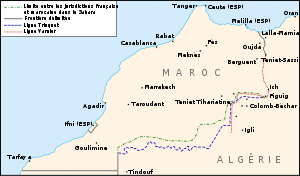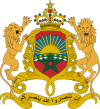- Sand War
-
Sand War 
Date October 1963 Location The former French colonial département of Saoura (Present-day Tindouf, Béchar Provinces.) Result The closing of the border south of Figuig, Morocco/Béni Ounif, Algeria Territorial
changesNone Belligerents  Morocco
Morocco Algeria
AlgeriaCasualties and losses 39 killed 300 killed The Sand War or Sands War occurred along the Algerian-Moroccan border in October 1963, and was a Moroccan attempt to claim the Tindouf and the Bechar areas that France had annexed to French Algeria a few decades earlier.
Contents
Background
Three factors contributed to the outbreak of this conflict: the absence of a precise delineation of the border between Algeria and Morocco, the discovery of important mineral resources in the disputed area, and the Moroccan irredentism fueled by the Greater Morocco[1] ideology of the Istiqlal Party and Allal al-Fassi.[2]
Before French colonization of the region in the nineteenth century, part of south and west Algeria were under Moroccan influence and no border was defined.[3] In the Treaty of Lalla Maghnia (March 18, 1845), which set the border between French Algeria and Morocco, it is stipulated that "a territory without water is uninhabitable and its boundaries are superfluous" [4] the border is delineated over only 165 km.[5] Beyond that there is only one border area, without limit, punctuated by tribal territories attached to Morocco or Algeria. After the colonization of Morocco in 1912, the French administration set borders between the two territories, but these tracks were often misidentified (Varnier line in 1912, Trinquet line in 1938), and varied from one map to another,[6] since for the French administration these were not international borders and the area was virtually uninhabited.[7] The discovery of large deposits of oil and minerals (iron, manganese) in the region led France to define more precisely the territories, and in 1952 the French decided to integrate Tindouf and Colomb-Bechar to the French departments of Algeria.[8]
The last bloody years of the FLN's rebellion had been fought essentially to prevent France from splitting the Sahara regions from the emerging Algerian state, and thus neither Ben Bella nor the rest of the wartime FLN were inclined to give them up to Morocco when independence was achieved. The Algerians therefore did not recognize Morocco's historical or political claims of Greater Morocco[1] that includes Bechar and Tindouf Province. Instead, they perceived the Moroccan demands as an attempt to infringe the country's hard-won independence and pressure it when it was at its weakest. Algeria was still reeling from the enormous damage caused by the Algerian War, and the government scarcely held control over its entire territory: significantly, a Berber anti-FLN rebellion under the leadership of Hocine Aït Ahmed had recently flared up in the Kabyle mountains. Tension escalated as neither side wanted to back down.
The war
Skirmishes along the border eventually escalated into a full-blown confrontation, with intense fighting around the oasis towns of Tindouf and Figuig. The Algerian army, recently formed from the guerrilla ranks of the FLN's Armée de Libération Nationale (ALN) was still geared towards asymmetric warfare, and had little heavy equipment.[9] They were still battle-ready and had tens of thousands of experienced veterans, and strengthening the armed forces had been a top priority for the military-dominated post-war government. On the other hand, while the modern, western-equipped Moroccan army (France was the bigger arms seller to Morocco at that time) was superior on the battlefield,[3][10] it did not manage to penetrate into Algeria. The Algerians had counted on hit-and-run attacks as their main strategy, but the Moroccans managed to counter this approach. The Moroccans built Fortified Sand Walls. These Sand Walls had land mines and electronic warning systems, as well as strong defenses placed by the Moroccan troops. The tactic was later used in the Western Sahara War. The war reached a stalemate and after the intervention of the Organization of African Unity (OAU) and the Arab League, it was broken off after approximately three weeks. The OAU eventually managed to arrange a formal cease-fire on February 20, 1964.[11] A peace agreement was then reached after Arab League mediation, and a demilitarized zone instituted but hostilities simmered.
Results
The Sand War laid the foundations for a lasting and often intensely hostile rivalry between Morocco and Algeria, exacerbated by the differences in political outlook between the conservative Moroccan monarchy and the revolutionary, Arab nationalist Algerian military government.[3][12] Final border demarcation in the Tindouf area was not reached until many years later, in a negotiation process stretching from 1969 to 1972, with Algeria offering Morocco shares in the iron ore earnings from Tindouf for recognition of its borders.
The governments of both Morocco and Algeria used the war to describe opposition movements as unpatriotic. The Moroccan UNFP and the Algerian-Berber FFS of Aït Ahmed both suffered as a result of this. In the case of UNFP, its leader, Mehdi Ben Barka, sided with Algeria, and was sentenced to death in absentia as a result. In Algeria, the armed rebellion of the FFS in Kabylie fizzled out, as commanders defected to join the national forces against Morocco.
Many have argued that the Sand War and its bitter legacy was a factor in the attitude of Algeria towards the conflict in Spanish Sahara in the 1970s. In 1975, Morocco took control of this territory, now known as Western Sahara, while Algeria began backing politically and militarily an independence-minded Sahrawi guerrilla organization, the Polisario Front.
See also
- List of modern conflicts in North Africa
Notes
- ^ a b Touval 1967, p. 106.
- ^ Biography of Allal al-Fassi
- ^ a b c Security Problems with Neighboring States - Countrystudies.us
- ^ Article 6 du traité, cité par Zartman, page 163
- ^ Reyner 1963, p. 316.
- ^ Reyner 1963, p. 317.
- ^ Heggoy 1970.
- ^ Farsoun & Paul 1976, p. 13.
- ^ How Cuba aided revolutionary Algeria in 1963 - themilitant.com
- ^ Armed Conflict Events Data - Onwar.com
- ^ The 1963 border war and the 1972 treaty - Arabworld.nitle.org
- ^ Algiers and Rabat, still miles apart - Le Monde Diplomatique
References
- Farsoun, K.; Paul, J. (1976), "War in the Sahara: 1963", Middle East Research and Information Project (MERIP) Reports 45: 13–16, JSTOR 3011767. Link requires subscription to Jstor.
- Heggoy, A.A. (1970), "Colonial origins of the Algerian-Moroccan border conflict of October 1963", African Studies Review 13 (1): 17–22, JSTOR 523680. Link requires subscription to Jstor.
- Reyner, A.S. (1963), "Morocco's international boundaries: a factual background", Journal of Modern African Studies 1 (3): 313–326, JSTOR 158912. Link requires subscription to Jstor.
- Touval, S. (1967), "The Organization of African Unity and African borders", International Organization 21 (1): 102–127, JSTOR 2705705. Link requires subscription to Jstor.
Further reading
Categories:- Conflicts in 1963
- History of Algeria
- Wars involving Algeria
- Wars involving Morocco
- Wars involving the states and peoples of Africa
- 1963 in Morocco
- 1963 in Algeria
Wikimedia Foundation. 2010.

